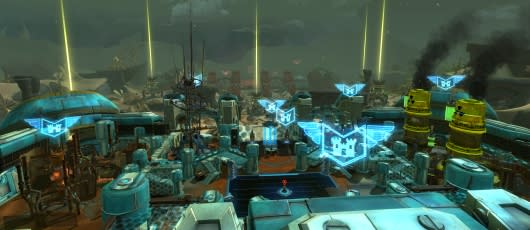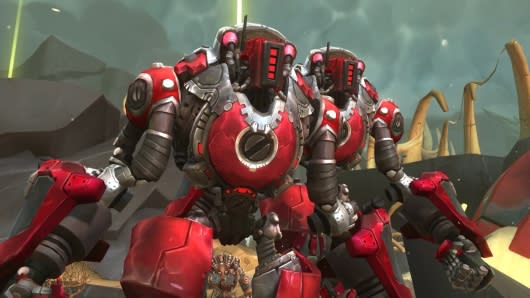PAX East 2014: WildStar shows off Warplots at last
Do you want to go to war in WildStar? Then you're going to want a stronghold. No, that's not right, you're going to want a fortress. You're going to want a fortification that makes others quake in terror. And then you're going to want to drop that fortification down on your enemy's front lawn and claim their territories while laying waste to their fortifications.
Welcome to Warplots. They're the game's answer to player-made fortresses and high-end battlegrounds all at once. More specificially, they're team-based 40 vs. 40 maps that drop you into a race to tear down your enemy. At either end sits the carefully constructed fortress held by each team, in the middle sit resource nodes, and both sides are pushed together to be the last side standing or the one putting a fortress back together post-battle.
Want to know more? That's a good thing. Take a look at the typical WildStar trailer past the cut, and then let's talk details.
Let's start with the basics. Like the man says, you're going to need to get a war party together, something you can only do once you're 50. Doing so is easy -- you create one, no muss, no fuss. War parties act as a guild-like team with a maximum of 80 members and no minimum. Each war party has a team rating, while each individual member also has an individual rating. You can also queue up as a mercenary, filling out an empty slot in a war party. Non-war party members get the usual rewards of prestige and experience for participation, but don't acquire any war party-specific rewards like warcoins (more on those in a moment).
Once you've formed a war party, you get your stock warplot, along with a recall ability to hop back there much like with your house. The stock warplot comes with all of the standard amenities such as power cores, ramps, choke points, and so forth. It's lacking a lot of elements, though, things like traps and guards and cannons and hazards and all the other lovely components that will ensure attackers can't even get through the front door. How do you get all of that stuff in place?
Why, you socket it! Yes, it's much like the housing system with plugs and sockets. Two sockets sit in the entrance ways, two sit on the outer sides of the base, one in the front, one in the back, and one in the center.

Buying plugs for these sockets requires warcoins. You start out with 500, enough to put in some basic components. These warcoins are earned by war parties as a whole, not by individuals, and ranks can be set to narrow the field of who's allowed to spent the coins. They're earned as you would expect, by taking part in warplot battles, with more earned for a win and more lost as damage racks up on your base. Some plugs are also crafted or earned through other means, but the vast majority require the special currency.
And yes, long-term damage is a consideration. Warplots are not immune to the effects of a battle. If a component is destroyed in the midst of a battle, you can repair it with match resources, but damage that isn't fixed remains from match to match. Warcoins can be spent to repair damaged structures, but you can also simply charge into the next battle and hope to acquire the resources to repair things in-battle. As a result, you can be a bit more risky if you want to, or you can keep your plot in fighting shape even at the cost of a few extra coins.
So what purposes do the plugs serve? The single sockets each have a single purpose. While there are several plugs that can go into the socket in the front, all of them come down to transport options; flinging you toward resource nodes, offering you a quick recall option, things of that nature. The rear socket offers a space for various superweapons, tools that can be unleashed for a resource cost in the midst of a battle. All straightforward.
Meanwhile, the two entrance sockets and the two courtyard sockets both offer two different options. For instance, the entrance sockets can slot in structures that either give your war party a boost or that boost your plot as a whole. You could boost the health of your structures or of your fellow war party members, for instance, improve your guards or improve your team's damage, things like that.
Courtyard sockets can accept either hazard plugs or guard plugs. Hazard plugs are fairly straightforward, forcing attackers to deal with an unusually hostile environment once within the base. Guard plugs, meanwhile, can produce a variety of different unit types that can be sent in varying directions. You can use them as a defensive force to slow down base attacks; you can also put them on the offensive and have them push against the enemy lines if you'd prefer. You can also use resources to spawn extra units if you absolutely need more forces, lending an air of RTS strategy to the combat mode.

Last but not least, there's the center socket. There's only one thing that this can support: a boss-summoning square. Beat a boss, get a token, and use it to summon a big 20-person version of that boss. (You can also purchase some basic versions for an outlay of a few more warcoins.) The boss can be used for defense or offense, harassing the enemy, or defending your own resources. Keep in mind that each token is only usable once, however; once the boss is destroyed or the match ends, the boss is gone for good.
There are also freely placed defensive options available, tricks like land mines, stationary turrets, and so forth. These are similarly gone for good if destroyed. There's a maximum of 100 such objects on your plot, and they can be placed out in the world as well, but can't be placed within the enemy base. So you can't just set up turrets to get rid of your enemy's generators.
Right, the generators, hadn't mentioned those. Destroying your enemy's two generators is one of the ways to win the match, after all. The other is by depleting your enemy's energy reserves; energy is constantly decreasing slowly, and it decreases by another chunk each time a structure is destroyed or a player is killed. So you can make a coordinated strike against the generators, breaking past the defenses of the base interior, or you can tear down the facilities within the boost while taking out numerous members of your opposing team.
Not that you're out of the running when your warplot is damaged. Energy is only one resource in warplot matches, the other being nanopacks. These serve as all-purpose building materials and can be used to repair damaged buildings, fuel the superweapon, produce more guards, and so forth. You can also upgrade your structures twice in the midst of the battle, giving you an extra little edge as you smash down your opponents. Capturing nodes also make enemy generators a bit more vulnerable via stacking debuffs, offering incentives to hold the midfield even though it's not specifically required.
Pleasantly enough, the warplot matching system doesn't only pair you up with players of similar ratings, as it also takes into consideration how much stuff you have on a warplot. It's also fully viable for you to have a war party that doesn't consist of a full 40 people, although the downside is that you won't be able to predict who joins up with you in the midst of a battle, so your rating may swing a bit more.

There's obviously space that the designers want to expand. At launch, for instance, it's impossible to tell your base's spawning guards exactly where you want them to go. Some types of guard will head for the nearest nanopack node when set on offensive, some will simply march to the enemy base, but it'll be up to players to manage their own efforts alongside the NPC push. There's also no way to manually trigger traps in your base when you want to, relying simply upon enemy players walking into danger.
Still, it's a chance to build your own lair and then pit it against enemy lairs, building up, repairing, and throwing it around again. If you want the convenience of instanced PvP along with the feeling of a personal fortress, there are no finer options available. And who doesn't want to have a lair with a big orbital laser available on demand?

Massively's on the ground in Boston during the weekend of April 11th to 13th, bringing you all the best news from PAX East 2014. Whether you're dying to know more about WildStar, Landmark, or any MMO in between, we aim to have it covered!


